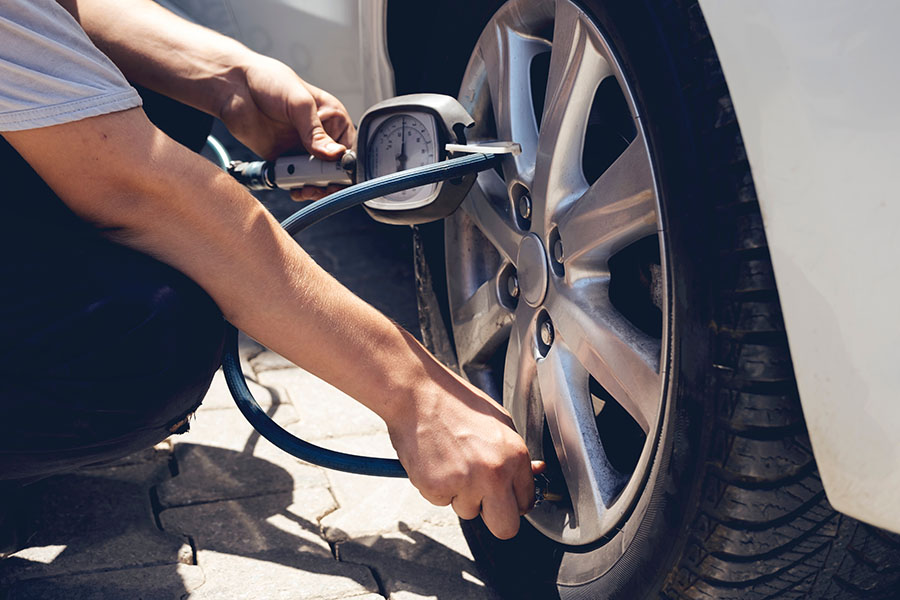Nissan GT-R is equipped with Tire Pressure Monitoring System (TPMS) for the purpose of warning the driver when one or more of the tires are significantly under-inflated, creating a potentially unsafe driving condition. In this article we discuss the reasons for the amber colored TPMS warning light in GT-R, and how you can reset it.

The TPMS warning light illuminates in Nissan GT-R when air pressure is low in one or more of the tires, battery has depleted in a pressure sensor, TPMS receiver module has malfunctioned, or a pressure sensor has been damaged.
Low tire pressure
When the amber colored TPMS warning light  turns on in your GT-R, stop your vehicle when it is safe to do so and check tire pressure on all the wheels. Driving on a significantly under-inflated tire causes the tire to overheat and can lead to tire failure.
turns on in your GT-R, stop your vehicle when it is safe to do so and check tire pressure on all the wheels. Driving on a significantly under-inflated tire causes the tire to overheat and can lead to tire failure.

Reinflate the tires
Reinflate all the tires of your GT-R to the manufacturer specified air pressure, which is mentioned on the vehicle placard or tire inflation pressure label usually located on the B-pillar or the edge of the driver door. If you can’t find the label, check the size of your tire which is mentioned on the sidewall of the tire, and match it to the tire pressure information shown below. These are official cold tire pressure values for GT-R from Nissan.
Summer tires
- Front: 255/40ZRF20 (97Y): 30 psi
- Front: 255/40ZRF20 (97Y): 32 psi (NISMO and Track edition engineered by nismo models)
- Rear: 285/35ZR- F20 (100Y): 29 psi
All-season tires
- Front: 255/40RF20 97W: 32 psi
- Rear: 285/35R- F20 100W: 30 psi

Resetting the TPMS warning light
After you have inflated all the tires to the correct air pressure, the TPMS warning light will turn off automatically when the vehicle is driven at speeds above 16 MPH (25 km/h). Nissan GT-R uses the direct method for monitoring tire pressure, which means a pressure sensor actively records the internal pressure and air temperature of the tire on each wheel. There is no need to reinitialize the TPMS system in order to reset the warning light. There is no reset button like the one you see in vehicles with indirect TPMS system which uses ABS sensors to detect low tire pressure.
If the low tire pressure light does not turn off automatically after reinflating the tires in your GT-R, increase the tire pressure by 5 psi on top of the factory recommended value, and drive your vehicle for at least 10 miles (16 km). After the TPMS warning light turns off, and the vehicle has been parked for a few hours, reduce the tire pressure to the factory recommended value.
Chilly weather can turn on low tire pressure light in GT-R
Cold weather is one of the most common cause for low tire pressure warning light in Nissan GT-R. When analyzing WheelsJoint’s statistical data, it has been observed that there is sharp rise in the number of searches for TPMS warning light causes at the start of every winter season, about three times higher as compared to mid summer season.

The air, like most other substances, expands when heated and contracts when cooled. So when the weather gets colder, the tire pressure decreases, which could trigger TPMS warning light in GT-R. The tire pressure will vary with temperature by about 1 psi (7 kPa) for every 12°F (6.5°C).

Inflate tires when cold
Tire pressure in GT-R should always be set based on cold inflation tire pressure. This is defined as the tire pressure after the vehicle has not been driven for at least three hours, or driven less than 1 mile (1.6 km) after a three-hour period.
Do not adjust tire pressure when hot
The tires on your GT-R can get around 50 degrees hotter than the outside temperature when you’re driving, which increases the tire pressure by about 4 psi – this is normal and there should be no adjustment for this increased pressure.
Does altitude affect tire pressure?
Yes, altitude can change tire pressure values, but it is negligible and not a cause for concern. If you drive your GT-R from sea level to Mount Evans Scenic Byway in Colorado which is the highest paved road in North America at the altitude of 14,130 feet (4,307 m), the tire pressure should theoretically increase by approximately 6 psi. But, the decrease in ambient temperature at higher elevation contracts the air in tires and compensates for any altitude pressure changes.
Is it safe to drive GT-R with low tire pressure?
The driving characteristics of GT-R change even if the air pressure is 5 psi less than manufacturer’s recommended value: the braking distance can be longer, cornering worse, and at particularly high speeds there is even a risk that the tire will burst. Low tire pressure also increases tire wear, and the higher rolling resistance of the tire means higher fuel consumption. So it is recommended to reinflate the tires to the correct pressure as soon as possible.
Dead battery in a tire pressure sensor
Each tire pressure sensor in GT-R is powered by a built-in lithium-ion battery. When the battery is depleted, the sensor stops transmitting tire pressure information to the receiver module. When this happens, the TPMS warning light will flash every time the engine is started, and will remain illuminated until you turn off the vehicle.

How long do the pressure sensor batteries last?
The tire pressure sensor batteries usually last anywhere from 5 to 10 years in GT-R. When the battery is depleted, you must replace the sensor itself, as the battery is sealed into the sensor unit and is non-replaceable.
Identifying a faulty pressure sensor
The most reliable method for detecting a faulty tire pressure sensor or a sensor with dead battery is by testing each sensor with a scan tool. For example, MaxiTPMS TS408 is commonly used for diagnosing and programming tire pressure sensors. A sensor that is not detectable by the scanner is most likely defective and should be replaced with a new one.

If you don’t want to spend over a hundred bucks on a scanner, then head over to any reputable tire shop and perform a TPMS diagnostic scan of your GT-R. Some shops like Discount Tire and Pep Boys offer free of charge TPMS diagnostic services.
Installed new tires?
If a pressure sensor stopped responding after you installed new tires on your GT-R, it is possible the sensor got damaged during tire installation. These sensors are quite sensitive, and can be easily damaged if utmost care is not taken while changing tires.
Nissan GT-R TPMS user guide
 Low tire pressure warning light
Low tire pressure warning light
Your vehicle is equipped with a Tire Pressure Monitoring System (TPMS) that monitors the tire pressure of all tires except the spare tire (GT-R doesn’t come with a spare tire). The low tire pressure warning light warns of low tire pressure or indicates that the TPMS is not functioning properly. After the ignition switch is placed in the ON position, this light illuminates for about 1 second and turns off.
If the vehicle is being driven with low tire pressure, the warning light will illuminate. The “Tire Low Pressure – Visit Dealer” warning also appears in the vehicle information display.
When the low tire pressure warning light illuminates, you should stop and adjust the tire pressure to the recommended COLD tire pressure shown on the Tire and Loading Information label. The low tire pressure warning light does not automatically turn off when the tire pressure is adjusted. After the tire is inflated to the recommended pressure, the vehicle must be driven at speeds above 16 MPH (25 km/h) to activate the TPMS and turn off the low tire pressure warning light. Use a tire pressure gauge to check the tire pressure. The “Tire Pressure Low – Visit Dealer” warning is active as long as the low tire pressure warning light remains illuminated.
TPMS malfunction:
If the TPMS is not functioning properly, the low tire pressure warning light will flash for approximately 1 minute when the ignition switch is placed in the ON position. The light will remain on after the 1 minute. Have the system checked. It is recommended you visit a NISSAN dealer for this service. The “Tire Low Pressure – Visit Dealer” warning does not appear if the low tire pressure warning light illuminates to indicate a TPMS malfunction.
TPMS only activates above 16 mph
The TPMS will activate only when the vehicle is driven at speeds above 16 MPH (25 km/h). Also, this system may not detect a sudden drop in tire pressure (for example a flat tire while driving).
Must drive vehicle above 16 mph after inflating tires
The low tire pressure warning light does not automatically turn off when the tire pressure is adjusted. After the tire is inflated to the recommended pressure, the vehicle must be driven at speeds above 16 MPH (25 km/h) to activate the TPMS and turn off the low tire pressure warning light. Use a tire pressure gauge to check the tire pressure.
Signal interference
Some devices and transmitters may temporarily interfere with the operation of the TPMS and cause the low tire pressure warning light to illuminate. Some examples are:
- Facilities or electric devices using similar radio frequencies are near the vehicle.
- If a transmitter set to similar frequencies is being used in or near the vehicle.
- If a computer (or similar equipment) or a DC/AC converter is being used in or near the vehicle.
Low tire pressure warning light may illuminate in the following cases.
- If the vehicle is equipped with a wheel and tire without TPMS.
- If the TPMS has been replaced and the ID has not been registered.
- If the wheel is not originally specified by NISSAN.
Additional information
- The TPMS will activate only when the vehicle is driven at speeds above 16 MPH (25 km/h). Also, this system may not detect a sudden drop in tire pressure (for example a flat tire while driving).
- The low tire pressure warning light does not automatically turn off when the tire pressure is adjusted. After the tire is inflated to the recommended pressure, the vehicle must be driven at speeds above 16 MPH (25 km/h) to activate the TPMS and turn off the low tire pressure warning light. Use a tire pressure gauge to check the tire pressure.
- The “TIRE LOW PRESSURE – VISIT DEALER” warning appears in the vehicle information display when the low tire pressure warning light is illuminated and low tire pressure is detected. The “TIRE LOW PRESSURE – VISIT DEALER” warning turns off when the low tire pressure warning light turns off. The “TIRE LOW PRESSURE – VISIT DEALER” warning appears each time the ignition switch is placed in the “ON” position as long as the low tire pressure warning light remains illuminated. The “TIRE LOW PRESSURE – VISIT DEALER” warning does not appear if the low tire pressure warning light illuminates to indicate a TPMS malfunction.
- The “FLAT TIRE – VISIT DEALER” warning appears in the vehicle information display when the low tire pressure warning light is illuminated and one or more flat tires are detected.
- Tire pressure rises and falls depending on the heat caused by the vehicle’s operation and the outside temperature. Do not reduce the tire pressure after driving because the tire pressure rises after driving. Low outside temperature can lower the temperature of the air inside the tire which can cause a lower tire inflation pressure. Altitude can also affect tire pressure. These may cause the low tire pressure warning light to illuminate. If the warning light illuminates, check the tire pressure for all four tires.
- GT-R vehicles are delivered from the factory with nitrogen-filled tires. For best performance, NISSAN recommends that GT-R owners maintain their vehicles by using nitrogen for tire inflation. Because nitrogen is more stable than compressed air, it is less prone to pressure fluctuation resulting from temperature variations. If nitrogen is not available, compressed air may be safely used under normal driving conditions. However, NISSAN recommends refilling with Nitrogen for maximum tire performance.
- The Tire and Loading Information label (also referred to as the vehicle placard or tire inflation pressure label) is located in the driver’s door opening.
- You can also check the pressure of all tires on the touch screen display. Refer to the separate Multi Function Display Owner’s Manual.
- The tire pressure sensor should be reset anytime the wheels or tires are removed or replaced.
- If the tire is removed in order to replace the tire pressure sensor battery, it may not be possible to reuse the removed tire from the wheel. To replace the tire pressure sensor battery, it is recommended you contact a GT-R certified NISSAN dealer.
Recommended video
Reset the entire system
If the low tire pressure warning light won’t turn off due to a glitch in the tire pressure monitoring system, it may be possible to reset the TPMS system by resetting all on-board computers in your GT-R. This method should only be considered as a last resort, when all else fails.

You can reboot all the on-board computers by disconnecting the main 12 volt battery for a few minutes. Remove the cable from the negative terminal of the battery first, then from the positive terminal. With the battery disconnected, press the horn button a few times and turn on the headlights to drain out all the residual electricity from the system. After about 15 minutes, reconnect the battery in reverse order: positive cable first, then negative cable.
Tire pressure keeps getting low
If the TPMS warning light turns on frequently in your GT-R, and the tire pressure is also decreasing after you have reinflated the tires, there may be an air leak. One or more of the tires may have been punctured by an external object, or the air may be leaking from a defective value stem.

Can I disable the TPMS system in GT-R?
No, the TPMS system is federally mandated, and cannot be disabled in Nissan GT-R. All vehicles must have a working tire pressure monitoring system to be legally compliant.
Use OBD2 scanner for diagnosis
Since Nissan GT-R is equipped with on-board diagnostics (OBD), a fault diagnosis can provide initial indications of where the malfunction is located. But when it comes to TPMS, a basic code reader will not suffice. You will need an advanced scanner to monitor TPMS data or read TPMS codes.

BlueDriver is a commonly used scanner by DIYers that can read TPMS codes for most vehicles and isn’t too expensive – costs about a hundred bucks. You can also clear the TPMS fault codes with this device which will turn off the warning light, but the light may come back on if the on-board diagnostic system detects a fault again.









